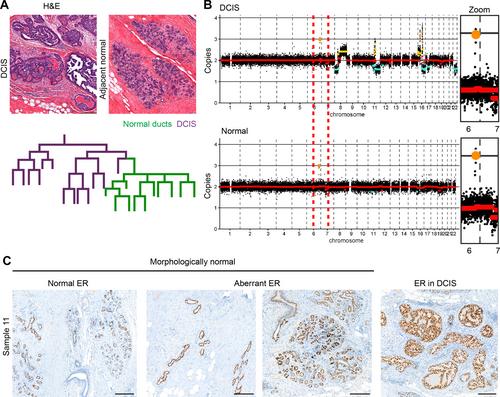Stefan J Hutten, Hendrik A Messal, Esther H Lips, Michael Sheinman, Marta Ciwinska, Esmee Braams, Carolien van der Borden, Petra Kristel, Saskia Stoffers, Lodewyk FA Wessels, Grand Challenge PRECISION Consortium, Jos Jonkers, Jacco van Rheenen, Jelle Wesseling, Colinda LGJ Scheele
下载PDF
{"title":"乳腺导管原位癌发生在形态正常的导管中突变细胞的克隆区内。","authors":"Stefan J Hutten, Hendrik A Messal, Esther H Lips, Michael Sheinman, Marta Ciwinska, Esmee Braams, Carolien van der Borden, Petra Kristel, Saskia Stoffers, Lodewyk FA Wessels, Grand Challenge PRECISION Consortium, Jos Jonkers, Jacco van Rheenen, Jelle Wesseling, Colinda LGJ Scheele","doi":"10.1002/path.6289","DOIUrl":null,"url":null,"abstract":"<p>Mutations are abundantly present in tissues of healthy individuals, including the breast epithelium. Yet it remains unknown whether mutant cells directly induce lesion formation or first spread, leading to a field of mutant cells that is predisposed towards lesion formation. To study the clonal and spatial relationships between morphologically normal breast epithelium adjacent to pre-cancerous lesions, we developed a three-dimensional (3D) imaging pipeline combined with spatially resolved genomics on archival, formalin-fixed breast tissue with the non-obligate breast cancer precursor ductal carcinoma <i>in situ</i> (DCIS). Using this 3D image-guided characterization method, we built high-resolution spatial maps of DNA copy number aberration (CNA) profiles within the DCIS lesion and the surrounding normal mammary ducts. We show that the local heterogeneity within a DCIS lesion is limited. However, by mapping the CNA profiles back onto the 3D reconstructed ductal subtree, we find that in eight out of 16 cases the healthy epithelium adjacent to the DCIS lesions has overlapping structural variations with the CNA profile of the DCIS. Together, our study indicates that pre-malignant breast transformations frequently develop within mutant clonal fields of morphologically normal-looking ducts. © 2024 The Authors. <i>The Journal of Pathology</i> published by John Wiley & Sons Ltd on behalf of The Pathological Society of Great Britain and Ireland.</p>","PeriodicalId":232,"journal":{"name":"The Journal of Pathology","volume":"263 3","pages":"360-371"},"PeriodicalIF":5.6000,"publicationDate":"2024-05-23","publicationTypes":"Journal Article","fieldsOfStudy":null,"isOpenAccess":false,"openAccessPdf":"https://onlinelibrary.wiley.com/doi/epdf/10.1002/path.6289","citationCount":"0","resultStr":"{\"title\":\"Ductal carcinoma in situ develops within clonal fields of mutant cells in morphologically normal ducts\",\"authors\":\"Stefan J Hutten, Hendrik A Messal, Esther H Lips, Michael Sheinman, Marta Ciwinska, Esmee Braams, Carolien van der Borden, Petra Kristel, Saskia Stoffers, Lodewyk FA Wessels, Grand Challenge PRECISION Consortium, Jos Jonkers, Jacco van Rheenen, Jelle Wesseling, Colinda LGJ Scheele\",\"doi\":\"10.1002/path.6289\",\"DOIUrl\":null,\"url\":null,\"abstract\":\"<p>Mutations are abundantly present in tissues of healthy individuals, including the breast epithelium. Yet it remains unknown whether mutant cells directly induce lesion formation or first spread, leading to a field of mutant cells that is predisposed towards lesion formation. To study the clonal and spatial relationships between morphologically normal breast epithelium adjacent to pre-cancerous lesions, we developed a three-dimensional (3D) imaging pipeline combined with spatially resolved genomics on archival, formalin-fixed breast tissue with the non-obligate breast cancer precursor ductal carcinoma <i>in situ</i> (DCIS). Using this 3D image-guided characterization method, we built high-resolution spatial maps of DNA copy number aberration (CNA) profiles within the DCIS lesion and the surrounding normal mammary ducts. We show that the local heterogeneity within a DCIS lesion is limited. However, by mapping the CNA profiles back onto the 3D reconstructed ductal subtree, we find that in eight out of 16 cases the healthy epithelium adjacent to the DCIS lesions has overlapping structural variations with the CNA profile of the DCIS. Together, our study indicates that pre-malignant breast transformations frequently develop within mutant clonal fields of morphologically normal-looking ducts. © 2024 The Authors. <i>The Journal of Pathology</i> published by John Wiley & Sons Ltd on behalf of The Pathological Society of Great Britain and Ireland.</p>\",\"PeriodicalId\":232,\"journal\":{\"name\":\"The Journal of Pathology\",\"volume\":\"263 3\",\"pages\":\"360-371\"},\"PeriodicalIF\":5.6000,\"publicationDate\":\"2024-05-23\",\"publicationTypes\":\"Journal Article\",\"fieldsOfStudy\":null,\"isOpenAccess\":false,\"openAccessPdf\":\"https://onlinelibrary.wiley.com/doi/epdf/10.1002/path.6289\",\"citationCount\":\"0\",\"resultStr\":null,\"platform\":\"Semanticscholar\",\"paperid\":null,\"PeriodicalName\":\"The Journal of Pathology\",\"FirstCategoryId\":\"3\",\"ListUrlMain\":\"https://onlinelibrary.wiley.com/doi/10.1002/path.6289\",\"RegionNum\":2,\"RegionCategory\":\"医学\",\"ArticlePicture\":[],\"TitleCN\":null,\"AbstractTextCN\":null,\"PMCID\":null,\"EPubDate\":\"\",\"PubModel\":\"\",\"JCR\":\"Q1\",\"JCRName\":\"ONCOLOGY\",\"Score\":null,\"Total\":0}","platform":"Semanticscholar","paperid":null,"PeriodicalName":"The Journal of Pathology","FirstCategoryId":"3","ListUrlMain":"https://onlinelibrary.wiley.com/doi/10.1002/path.6289","RegionNum":2,"RegionCategory":"医学","ArticlePicture":[],"TitleCN":null,"AbstractTextCN":null,"PMCID":null,"EPubDate":"","PubModel":"","JCR":"Q1","JCRName":"ONCOLOGY","Score":null,"Total":0}
引用次数: 0
引用
批量引用


 求助内容:
求助内容: 应助结果提醒方式:
应助结果提醒方式:


